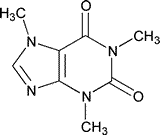Caffeine
1H-Purine-2,6-dione,3,7-dihydro-1,3,7-trimethyl-.
1,3,7-Trimethylxanthine [58-08-2].
Monohydrate 212.21 [5743-12-4].
»Caffeine is anhydrous or contains one molecule of water of hydration.It contains not less than 98.5percent and not more than 101.0percent of C8H10N4O2,calculated on the anhydrous basis.
Packaging and storage—
Preserve hydrous Caffeine in tight containers.Preserve anhydrous Caffeine in well-closed containers.
Labeling—
Label it to indicate whether it is anhydrous or hydrous.
Identification—
A:
Infrared Absorption á197Mñ.
B:
Dissolve about 5mg in 1mLof hydrochloric acid in a porcelain dish,add 50mg of potassium chlorate,and evaporate on a steam bath to dryness.Invert the dish over a vessel containing a few drops of 6Nammonium hydroxide:the residue acquires a purple color,which disappears upon the addition of a solution of a fixed alkali.
Water,Method IIIá921ñ—
Dry it at 80 for 4hours:the anhydrous form loses not more than 0.5%,and the hydrous form not more than 8.5%of its weight.
for 4hours:the anhydrous form loses not more than 0.5%,and the hydrous form not more than 8.5%of its weight.
Residue on ignition á281ñ:
not more than 0.1%.
Heavy metals,Method IIá231ñ:
0.001%.
Readily carbonizable substances á271ñ—
Dissolve 0.5g in 5mLof sulfuric acid TS:the solution has no more color than Matching Fluid D.
Organic volatile impurities,Method Iá467ñ:
meets the requirements.
Other alkaloids—
To 5mLof a solution (1in 50)add mercuric-potassium iodide TS:no precipitate is formed.
Chromatographic purity—
Mobile phase
,System suitability preparation,Standard preparation,and Chromatographic system—Proceed as directed in the Assay.
Test preparation—
Use the Assay preparation.
Procedure—
Inject a volume (about 10µL)of the Test preparationinto the chromatograph,record the chromatogram,and measure all of the peak responses.Calculate the percentage of each impurity in the portion of Caffeine taken by the formula:
100(ri/rs),
in which riis the peak response for each impurity;and rsis the sum of the responses of all the peaks:not more than 0.1%of any individual impurity is found;and not more than 0.1%of total impurities is found.
Assay—
Mobile phase—
Transfer about 1.64g of anhydrous sodium acetate,accurately weighed,to a 2-liter volumetric flask,dissolve in and dilute with water to volume,and mix.Transfer 1910mLof this solution to another 2-liter volumetric flask,add 50mLof acetonitrile and 40mLof tetrahydrofuran,and mix.Adjust with glacial acetic acid to a pHof 4.5,mix,filter,and degas.
System suitability preparation—
Transfer about 2mg of theophylline,accurately weighed,to a 100-mLvolumetric flask,add about 50mLof Mobile phase,shake,and sonicate,if necessary,to dissolve.Dilute with Mobile phaseto volume,and mix.
Standard preparation—
Transfer an acccurately weighed quantity of about 5.0mg of USP Caffeine RSto a 25-mLvolumetric flask,add 5.0mLof System suitability preparationand 10mLof Mobile phase,shake,and sonicate,if necessary,to dissolve.Dilute with Mobile phaseto volume,mix,and filter.
Assay preparation—
Transfer about 10mg of Caffeine,accurately weighed,to a 50-mLvolumetric flask,add 10mLof Mobile phase,shake,and sonicate,if necessary,to dissolve.Dilute with Mobile phaseto volume,mix,and filter.
Chromatographic system
(see Chromatography á621ñ)—The liquid chromatograph is equipped with a 275-nm detector and a 4.6-mm ×15-cm column containing packing L1.The flow rate is about 1mLper minute.Chromatograph the Standard preparation,and record the peak responses as directed for Procedure:the relative retention times for theophylline and caffeine are about 0.69and 1.0,respectively;the resolution,R,between theophylline and caffeine is not less than 6.0;the tailing factor for each of the peaks identified in the chromatogram is not more than 2.0;and the relative standard deviation is not more than 2.0%.
Procedure—
Separately inject equal volumes (about 10µL)of the Standard preparationand the Assay preparationinto the chromatograph,record the chromatograms,and measure the responses for the caffeine peaks.Calculate the quantity,in mg,of C8H10N4O2in the portion of Caffeine taken by the formula:
50C(rU/rS),
in which Cis the concentration,in mg per mL,of USP Caffeine RSin the Standard preparation;and rUand rSare the peak responses for caffeine obtained from the Assay preparationand the Standard preparation,respectively.
Auxiliary Information—
Staff Liaison:Salvador C.Salado,M.S.,Scientist and Latin American Liaison
Expert Committee:(PA3)Pharmaceutical Analysis 3
USP28–NF23Page 312
Pharmacopeial Forum:Volume No.30(4)Page 1168
Phone Number:1-301-816-8165
